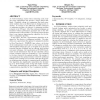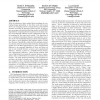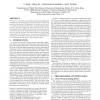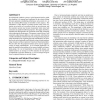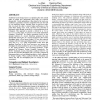114
Voted
ICCAD
2009
IEEE
14 years 10 months ago
2009
IEEE
As CMOS devices are scaled down into the nanometer regime, concerns about reliability are mounting. Instead of viewing nanoscale characteristics as an impediment, technologies suc...
119
Voted
ICCAD
2009
IEEE
14 years 10 months ago
2009
IEEE
As VLSI technology reaches 45nm technology node, leakage power optimization has become a major design challenge. Threshold voltage (vt) assignment has been extensively studied, du...
105
Voted
ICCAD
2009
IEEE
14 years 10 months ago
2009
IEEE
Current logic synthesis techniques are ineffective for arithmetic circuits. They perform poorly for XOR-dominated circuits, and those with a high fan-in dependency between inputs ...
118
click to vote
ICCAD
2009
IEEE
14 years 10 months ago
2009
IEEE
The problem of calculating accurate impact of crosstalk on a circuit considering its inherent logic and timing properties is very complex. Although it has been widely studied, it ...
122
Voted
ICCAD
2009
IEEE
14 years 10 months ago
2009
IEEE
With the adoption of ultra regular fabric paradigms for controlling design printability at the 22nm node and beyond, there is an emerging need for a layout-driven, pattern-based p...
87
Voted
ICCAD
2009
IEEE
14 years 10 months ago
2009
IEEE
A generalized Hamiltonian method (GHM) is proposed for passivity test of descriptor systems (DSs) which describe impedance or admittance input-output responses. GHM can test passi...
103
click to vote
ICCAD
2009
IEEE
14 years 10 months ago
2009
IEEE
We propose a layout-driven test-architecture design and optimization technique for core-based system-on-chips (SoCs) that are fabricated using three-dimensional (3D) integration. ...
111
Voted
ICCAD
2009
IEEE
14 years 10 months ago
2009
IEEE
Decoupling capacitance (decap) is an efficient way to reduce transient noise in on-chip power supply networks. However, excessive decap may cause more leakage power, chip resource...
115
Voted
ICCAD
2009
IEEE
14 years 10 months ago
2009
IEEE
In a behavioral synthesis system, a typical approach used to guide the scheduler is to impose hard constraints on the relative timing between operations considering performance, a...
97
Voted
ICCAD
2009
IEEE
14 years 10 months ago
2009
IEEE
Traditional circuit design focuses on optimizing the static critical paths no matter how infrequently these paths are exercised dynamically. Circuit optimization is then tuned to ...

